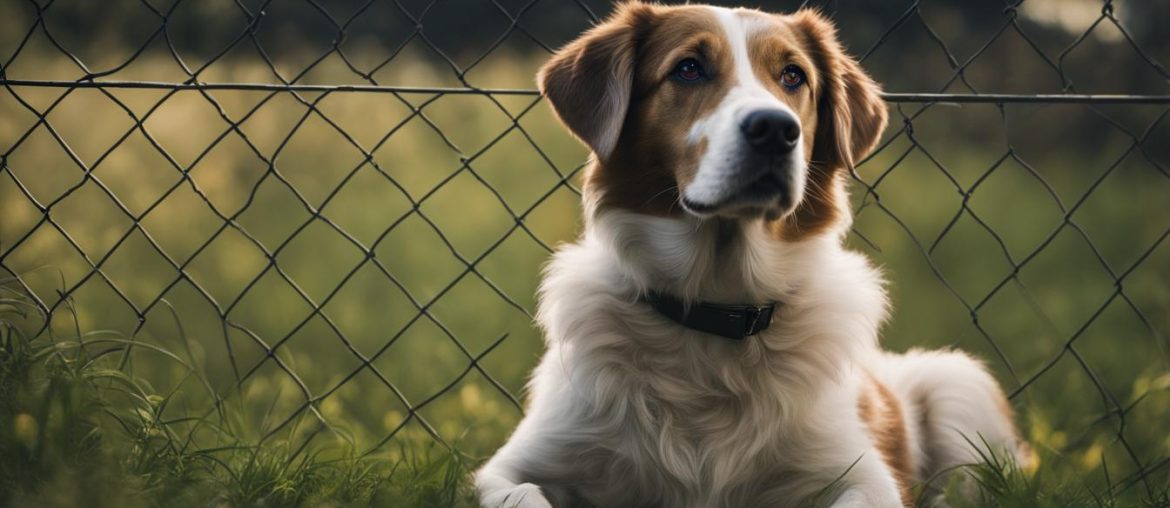As a pet owner, I understand the importance of keeping our beloved dogs safe within our property. With the increasing popularity of underground fences for dogs, I wanted to delve deeper into their effectiveness, the benefits they offer, and the pros and cons associated with their use. In this comprehensive study, I will analyze the key aspects of underground fences to help you make an informed decision for your furry friend.
Key Takeaways:
- Underground fences for dogs are a cost-effective alternative to traditional fences.
- These fences are highly adaptable and can be installed on any type of terrain.
- Training is crucial for the successful use of underground fences.
- While effective, there are safety considerations to keep in mind.
- Alternative options such as physical fences and leash training are available.
The Advantages of Underground Fences for Dogs
Underground fences offer several advantages for dog owners. Firstly, they are a cost-effective option compared to traditional fences, as the installation is often less expensive. Additionally, they are highly adaptable and can be installed on any type of terrain. The invisible nature of these fences adds to the aesthetics of the yard and allows for uninterrupted views. Electric fences can also be installed more quickly compared to conventional fences, saving time and labor.
Another advantage of underground fences is that they provide a greater sense of freedom for dogs. Unlike traditional fences, dogs can move around the yard without feeling confined. This is especially beneficial for dogs that require ample exercise and mental stimulation. Additionally, underground fences help to maintain the natural view of the property, as they do not obstruct sightlines with visible barriers, like traditional fences do.
“Underground fences offer a balance between containment and freedom for dogs. They provide a secure boundary without visually interrupting the natural landscape.” – Dog Training Expert
Furthermore, underground fences are customizable and can be tailored to suit the specific needs of each dog. The intensity of the electric shock can be adjusted to ensure it is effective yet humane. Some systems also offer features like progressive correction, which increases the level of static stimulation if the dog continues to approach the boundary. This helps to reinforce the training and prevent boundary breaches.
| Advantages of Underground Fences for Dogs |
|---|
| Cost-effective compared to traditional fences |
| Adaptable to any type of terrain |
| Uninterrupted views and aesthetic appeal |
| Quick and easy installation |
| Greater sense of freedom for dogs |
| Customizable to suit individual dog needs |
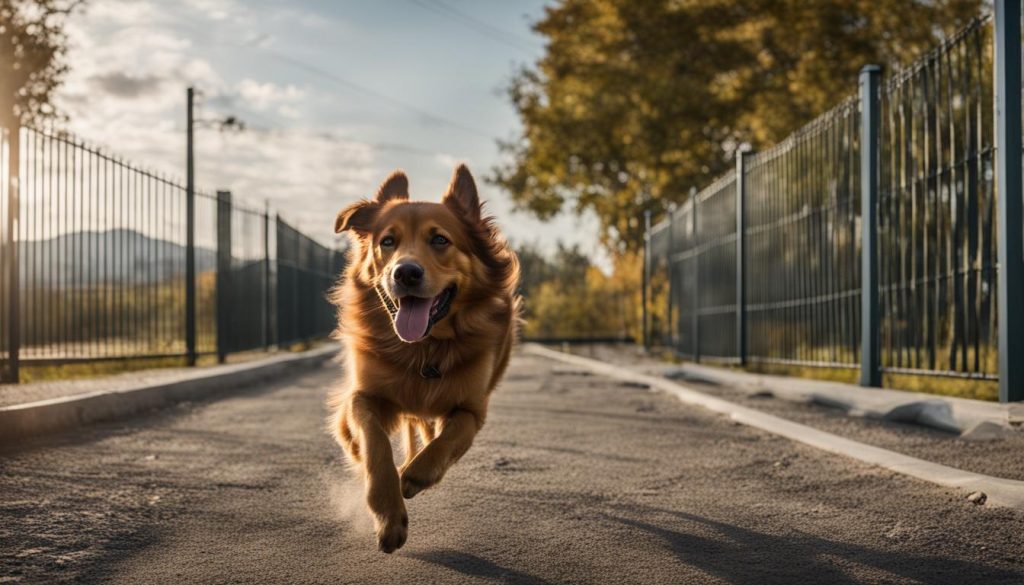
Enhancing Safety and Security
In addition to the aforementioned advantages, underground fences also enhance safety and security for dogs. By keeping them contained within the property, these fences help prevent dogs from wandering off and potentially getting lost or injured. With the proper training and reinforcement, dogs quickly learn to associate the warning beep with the boundary, reducing the likelihood of straying.
Furthermore, underground fences can protect dogs from external threats, such as approaching stray dogs or wildlife. While not physically visible, these fences act as a deterrent, preventing unwanted intrusions into the yard. This provides peace of mind for dog owners, knowing that their pets are protected within the boundaries of their property.
Overall, the advantages of underground fences make them a popular choice for dog owners seeking a secure yet visually unobtrusive containment solution. These fences offer cost-effectiveness, adaptability, and freedom for dogs while maintaining the aesthetics of the yard. With the right training and customization, underground fences can provide an effective and safe environment for dogs to enjoy their outdoor space.
Training Dogs with Underground Fences
Training is a crucial aspect of using underground fences effectively. Dogs need to be introduced to the boundaries and taught to associate the warning beep with a potential electric shock. Most fencing companies provide training protocols and assistance to ensure a successful training process. I highly recommend owners to invest time and effort in properly training their dogs to avoid breaching the boundaries.
The Training Process
When training dogs with underground fences, it is essential to follow a structured and consistent approach. The training process typically involves the following steps:
- Introduce the dog to the boundaries: Start by using visual cues, such as flags or markers, to clearly define the boundaries of the containment area. Allow the dog to explore the area while closely supervising their behavior.
- Teach the dog the warning signal: Once the dog is familiar with the boundaries, introduce them to the warning beep that is emitted when they approach the boundary. Use positive reinforcement, such as treats or praise, to encourage the dog to retreat when they hear the warning beep.
- Introduce the correction: After the dog has learned to associate the warning beep with retreating, it is time to introduce the electric correction. This should only be done under the guidance of a professional trainer or fencing company representative, ensuring the correct intensity and duration of the correction.
- Monitor and reinforce training: Regularly observe the dog’s behavior around the boundaries and reinforce the training through consistent positive reinforcement. This can include rewarding the dog when they retreat upon hearing the warning beep or providing additional training sessions as needed.
By following these training steps and remaining patient and consistent, dog owners can help their pets understand the boundaries set by the underground fence and minimize the risk of breaches.
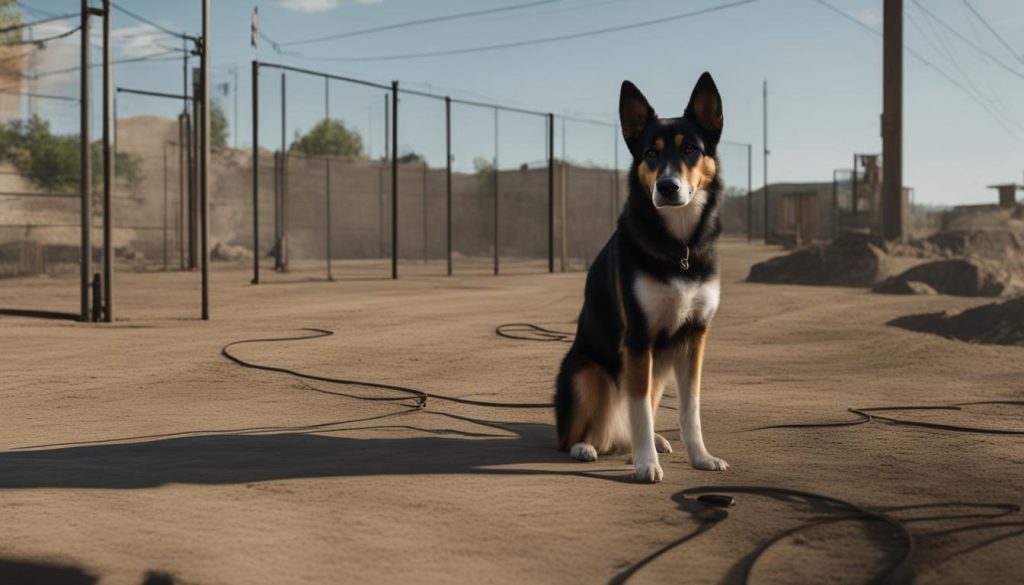
Tips for Successful Training
While training dogs with underground fences, there are a few additional tips that can contribute to a successful training process:
- Start training at an early age: It is easier to train puppies compared to adult dogs, as they are more receptive to learning and adapting to new systems.
- Be patient and consistent: Training takes time and repetition. Consistently reinforce the desired behavior and avoid punishing or scolding the dog for breaches during the training period.
- Supervise outdoor activities: Even after successful training, you should supervise the dog’s outdoor activities to ensure they are not becoming desensitized to the boundaries or engaging in behavior that may lead to breaches.
- Consult with professionals: If owners encounter difficulties during the training process, it is advisable to seek assistance from professional trainers or fencing companies who specialize in underground fence training.
By following these tips and dedicating time and effort to the training process, dog owners can maximize the effectiveness of underground fences as a containment solution for their pets.
Safety Considerations with Underground Fences
When considering the use of underground fences for dogs, you should keep safety in mind. While these fences can be effective in containing your pet within your property, there are certain factors that dog owners should be aware of to ensure the well-being of their furry friends.
Potential Hazards
One important consideration is that underground fences do not prevent hazards from entering your yard. Stray dogs, wild animals, or even unfamiliar humans may still find their way into your property, potentially posing a threat to your dog’s safety. You might want to regularly monitor your dog’s interactions and surroundings to minimize any risks.
Possible Frustration and Agitation
Dogs are inherently social animals, and seeing other dogs or humans just beyond their reach may lead to frustration and agitation. This can result in increased stress levels for your dog, potentially impacting their overall well-being. You should provide alternative outlets for socialization and play to ensure your dog’s mental and emotional health.
| Factors to Consider | Precautions to Take |
|---|---|
| Stray dogs and wild animals | Regularly inspect the perimeter and address any breaches promptly |
| Frustration and agitation | Provide supervised socialization and play opportunities for your dog |
“While underground fences provide a level of containment, remember that they are not foolproof. As responsible dog owners, we must remain vigilant and take additional precautions to ensure the safety and well-being of our beloved pets.”
By being aware of these safety considerations and taking the necessary precautions, dog owners can mitigate potential risks associated with the use of underground fences. Regularly assessing the effectiveness of the fence, providing appropriate training, and ensuring a safe environment for your dog are all essential aspects of responsible pet ownership.
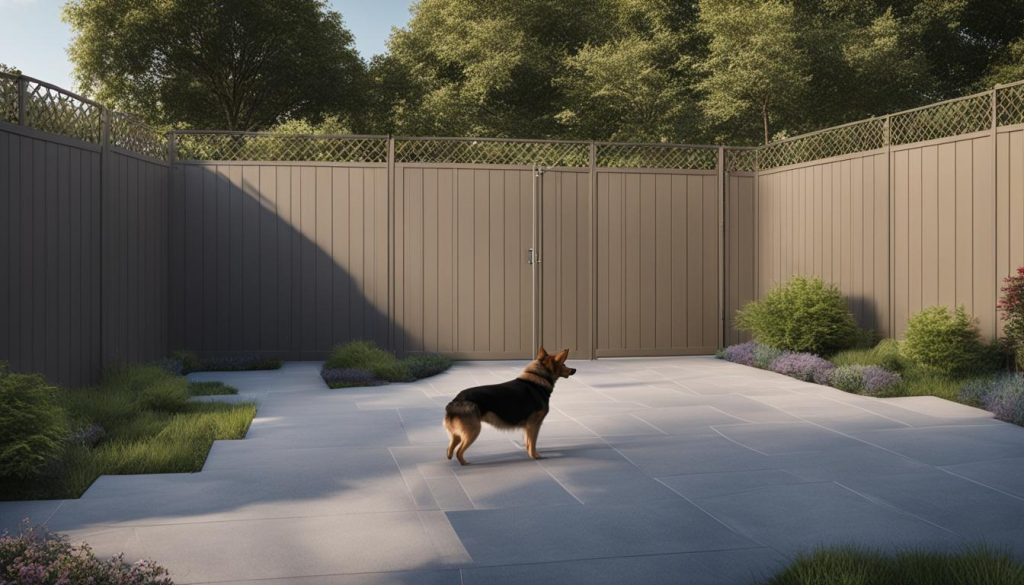
Alternatives to Underground Fences for Dogs
While underground fences may be suitable for some dog owners, there are alternative options available that can provide effective containment for dogs. I highly recommend dog owners to consider these alternatives and choose the option that best meets their specific needs and circumstances.
Physical Fences
A physical fence is often considered the safest choice for dog containment. It provides a solid barrier that prevents other animals or humans from entering the yard, ensuring the safety of both the dog and the surrounding environment. Physical fences come in various materials and styles, offering flexibility in terms of design and customization to match the aesthetics of the property.
Leash Training
Leash training is another viable alternative to underground fences. This method involves teaching the dog to walk on a leash and ensuring they are supervised and controlled while outside. Leash training allows for direct control and guidance, ensuring the dog does not wander off or encounter potential hazards. I highly recommend dog owners to invest time and effort into proper leash training to ensure a safe and enjoyable outdoor experience for both the dog and the owner.
Designated Play Areas and Supervised Outdoor Activities
Creating designated play areas within the property can also serve as an alternative to underground fences. These areas can be securely fenced or enclosed, providing a safe space for the dog to play and explore without the need for an entire yard containment system. Additionally, supervised outdoor activities, such as walks or playdates with other dogs, can provide a controlled and safe environment for the dog to enjoy outdoor experiences.
Each alternative to underground fences should be carefully considered based on factors such as the dog’s behavior, size, and breed, as well as the owner’s preferences and lifestyle. I highly recommend dog owners to prioritize the safety and wellbeing of their pets while choosing an appropriate containment option.
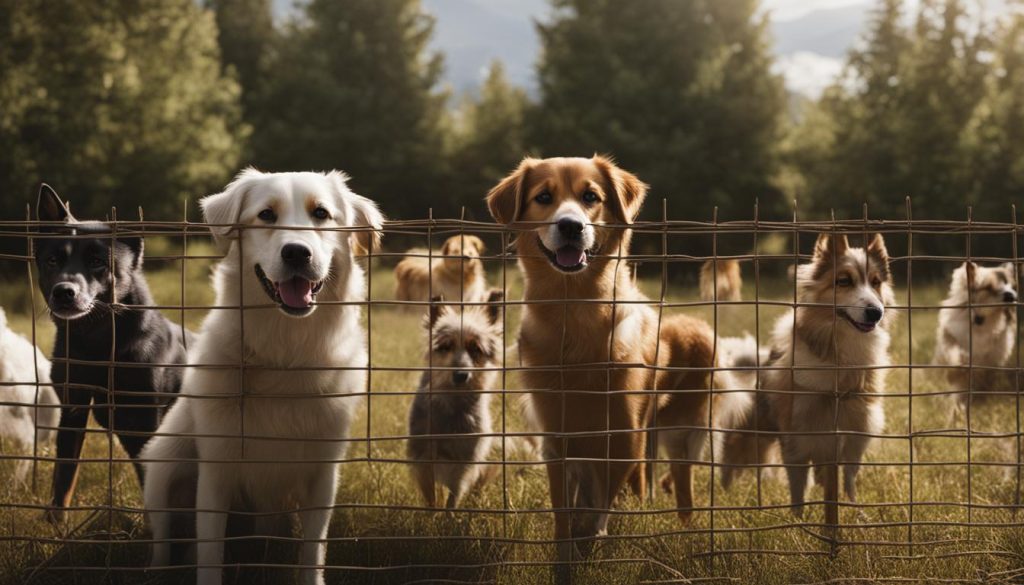
Effectiveness of Underground Fences for Dogs
When assessing the effectiveness of underground fences for dogs, several factors come into play. Proper training and reinforcement are crucial for the success of these containment systems. Dogs need to be introduced to the boundaries of the fence and trained to associate the warning beep with the possibility of an electric shock. The training process requires time and effort from the dog owner.
Although underground fences can effectively prevent dogs from leaving the yard, they do not offer protection against other animals entering the property. Dogs may become frustrated or agitated when they see other dogs or humans just beyond their reach, which can be a safety concern. Additionally, some dogs may become desensitized to the electric shock over time, leading to potential breaches.
Regular monitoring of the fence’s effectiveness is essential to address any potential issues promptly. Dog owners should stay vigilant and ensure that the fence is functioning correctly and that their pet is respecting its boundaries. You might want to address any breaches in a timely and appropriate manner to maintain the effectiveness of the underground fence.
Factors Affecting Effectiveness
The effectiveness of underground fences for dogs can vary depending on several factors. The size and breed of the dog, the training protocol implemented, and the overall safety features of the system all play a role. These factors should be carefully considered when selecting an underground fence to ensure it meets the specific needs of both the dog and the owner.
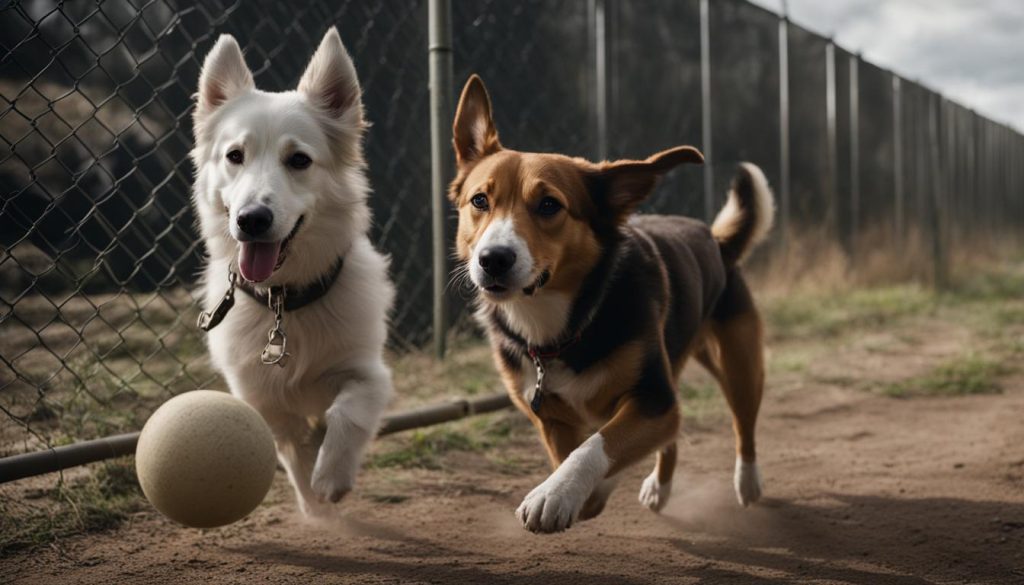
Table: Comparative Analysis of Underground Fences for Dogs
| Factors | Effectiveness | Safety | Longevity |
|---|---|---|---|
| Size and breed of the dog | Varies | Varies | Varies |
| Training protocol | Crucial | Important | Important |
| Safety features of the system | Depends on the brand | Depends on the brand | Depends on the brand |
Note: The data presented in this table is for illustrative purposes only and may not reflect the performance of specific brands or products.
Factors to Consider When Choosing an Underground Fence
When selecting an underground fence for your dog, there are several important considerations to keep in mind. Understanding these factors will help you make an informed decision and choose the right fence that meets your specific needs.
Size and Breed of Your Dog
The size and breed of your dog play a significant role in selecting the appropriate underground fence. Larger dogs may require stronger correction levels, while smaller dogs may need a more gentle approach. Additionally, specific breeds may have different behavioral tendencies that should be taken into account. Consulting with a professional or researching breed-specific characteristics can help guide your decision.
Terrain of Your Yard
The terrain of your yard is another crucial factor to consider. Different underground fence systems are designed to accommodate specific types of terrain, such as flat landscapes, hilly areas, or properties with rocky and uneven ground. I recommend that you choose a system that is compatible with your yard’s topography to ensure effective containment.
Training Support and Protocols
Proper training is essential for the successful implementation of an underground fence. When choosing a system, consider the training support and protocols provided by the fencing company. Look for comprehensive training materials, instructional videos, or professional assistance to help you train your dog effectively and ensure they understand the boundaries.
By carefully evaluating these important considerations, you can choose the right underground fence for your dog. Don’t forget that each dog is unique, so please select a system that takes into account your dog’s size, breed, and behavior. Additionally, ensuring compatibility with your yard’s terrain and having access to reliable training support will contribute to a successful and safe containment solution.
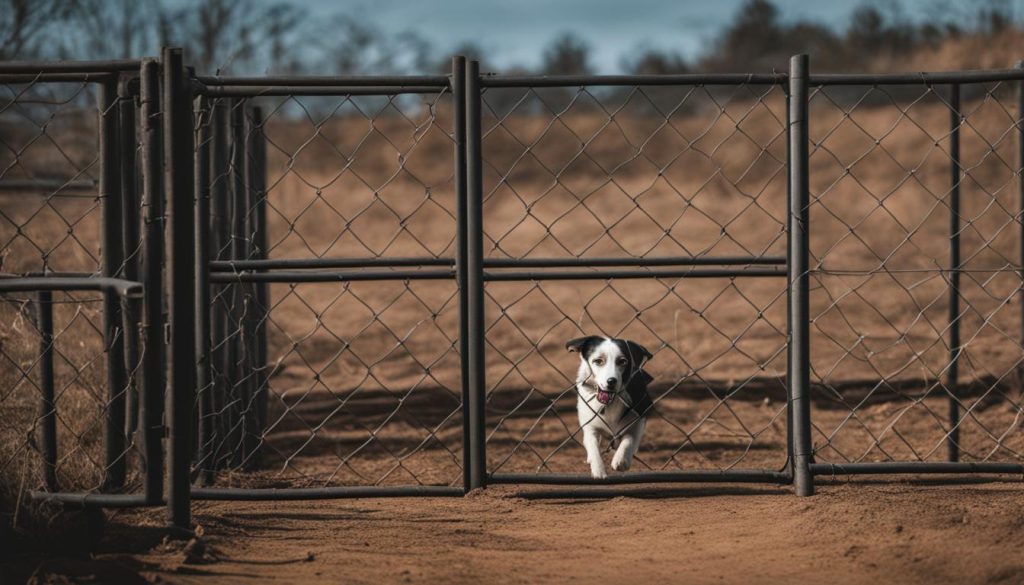
Ensuring Dog Owner Satisfaction with Underground Fences
When it comes to underground fences for dogs, ensuring dog owner satisfaction is paramount. To achieve this, a combination of factors needs to be considered, including proper training, effective communication with the fencing company, and regular maintenance of the fence.
One key aspect of dog owner satisfaction with underground fences is training. Investing time and effort in training your dog to understand the boundaries and the consequences of crossing them is crucial. By following the training protocols provided by the fencing company and consistently reinforcing the desired behavior, you can help your dog adapt to the system and avoid potential breaches.
Communication and collaboration with the fencing company are also essential. Regularly interacting with the company’s customer service representatives can help address any concerns or questions you may have about the fence. They can provide guidance on troubleshooting issues, scheduling maintenance visits, or even upgrading the system if necessary.
Maintenance of the fence is another crucial factor in ensuring dog owner satisfaction. Regularly inspecting the fence for any damage or malfunction and promptly addressing any issues can help maintain its effectiveness. Additionally, keeping the collar batteries charged and ensuring that the boundary flags are in place can help provide a consistent and reliable experience for your dog.
By incorporating these practices into your experience with an underground fence, you can increase your satisfaction as a dog owner. To put it simply, proper training, effective communication, and regular maintenance are key to ensuring the success and enjoyment of using an underground fence for your furry friend.
Final Thoughts
To sum it up, the question remains: Are underground fences for dogs effective? The answer is, they can be. When used in conjunction with proper training, monitoring, and consideration of safety factors, underground fences can provide an effective containment option for your furry friend.
However, you should carefully evaluate the pros and cons before making a decision. While underground fences are cost-effective and aesthetically pleasing, they do come with limitations. They do not prevent hazards from entering the yard and may not be suitable for dogs who easily become desensitized to the electric shock over time.
You might want to prioritize the safety and well-being of your dog when considering any containment option. If an underground fence is not the right fit for your dog, there are alternative options available such as physical fences, leash training, designated play areas, or supervised outdoor activities. Try to always choose the option that best suits your dog’s specific needs.
FAQ
Are underground fences for dogs effective in containing them within the property?
Underground fences can be effective in containing dogs within the property when used in conjunction with proper training and monitoring.
What are the advantages of using underground fences for dogs?
Underground fences offer cost-effectiveness, adaptability to any terrain, aesthetic appeal, and quicker installation compared to traditional fences.
How should dogs be trained to use underground fences?
Dogs should be introduced to the boundaries and taught to associate the warning beep with a potential electric shock. Proper training and reinforcement are essential.
What safety considerations should dog owners keep in mind with underground fences?
Underground fences do not prevent hazards from entering the yard, and dogs may become frustrated or agitated when they see other dogs or humans just beyond their reach.
What are the alternatives to underground fences for dogs?
Alternatives include physical fences, leash training, designated play areas, and supervised outdoor activities. Each alternative should be carefully considered based on the dog’s needs and circumstances.
How effective are underground fences for dogs?
The effectiveness of underground fences varies depending on factors such as training, reinforcement, and the individual dog’s response. Regular monitoring is important to address any potential breaches.
What factors should be considered when choosing an underground fence?
Factors such as dog size and breed, yard terrain, training protocols, and safety features should be taken into account when selecting an underground fence.
How can dog owner satisfaction with underground fences be ensured?
Adequate training, monitoring, and maintenance of the fence, as well as regular communication with the fencing company, can contribute to a positive experience and overall satisfaction.


